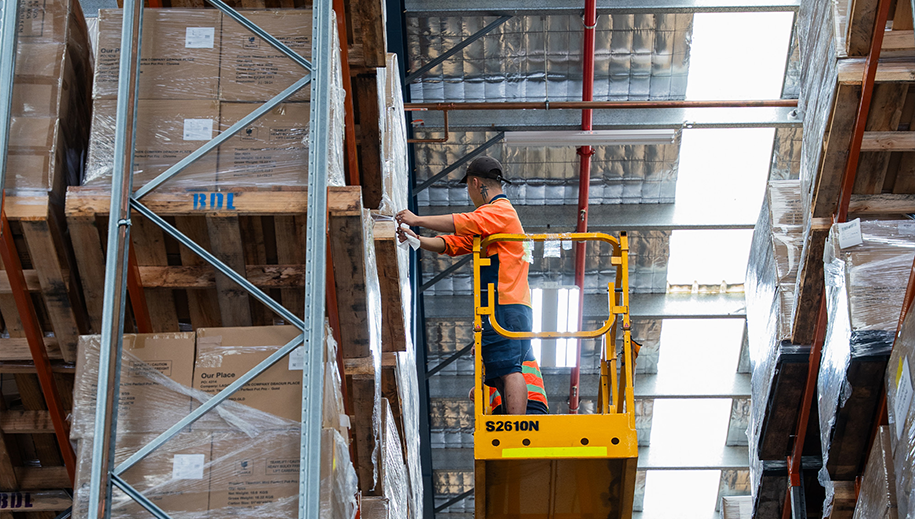
In today’s lightning-fast Australian eCommerce landscape, efficient warehousing isn’t just beneficial—it’s absolutely essential. Warehouse throughput serves as the powerful engine driving successful order fulfilment and customer satisfaction. Simply put, warehouse throughput measures the volume of goods moving through your warehouse within a specific timeframe. This article provides actionable insights on optimizing warehouse throughput for peak performance in your operations. At B dynamic Logistics, we understand that exceptional throughput underpins effective 3PL services for growing businesses.
Deciphering Warehouse Throughput: What Does It Really Mean?
Warehouse throughput extends beyond mere speed—it encompasses the entire efficiency ecosystem of your operation. Think of your warehouse as a motorway for goods: the smoother the traffic flow, the faster products reach their destination without compromising accuracy or safety.
“Warehouse throughput represents the metabolic rate of your fulfilment operation,” explains logistics consultant Emma Thornton. “It determines how quickly goods move from receiving to dispatch whilst maintaining quality standards.”
High throughput directly correlates with faster order processing, improved customer satisfaction, and healthier profit margins for Australian eCommerce businesses. In an era where consumers expect near-immediate gratification, optimized throughput isn’t optional—it’s imperative.
Why Optimise Warehouse Throughput? The Australian eCommerce Imperative
Australia’s unique geography—with widely dispersed population centres and vast distances—creates distinct logistical challenges. Optimising warehouse throughput delivers four smashing benefits particularly vital in this environment:
Faster Order Fulfilment: Meeting or exceeding increasingly demanding delivery expectations across Australia’s challenging geography. Research indicates that 68% of Australian online shoppers consider delivery speed when choosing retailers.
Reduced Operational Costs: Streamlined processes minimise resource wastage and labour inefficiencies. Our analysis shows businesses typically reduce operational costs by 15-22% through throughput optimisation.
Increased Scalability: Efficient operations handle seasonal peaks (like Christmas or Click Frenzy) and support business growth without developing bottlenecks. Properly optimised warehouses can manage up to 40% volume increases with minimal additional resources.
Improved Customer Satisfaction: Reliable, speedy service builds loyalty and reduces costly customer service issues. Studies demonstrate that 72% of Australian consumers cite accurate, on-time delivery as crucial to their repeat purchasing decisions.
In the competitive Australian market, efficient throughput isn’t merely desirable—it’s the cornerstone of eCommerce success.
Best Practices for Boosting Warehouse Throughput: Actionable Strategies
Let’s get down to brass tacks with these practical approaches:
Streamline Layout: Organise your warehouse to minimise travel time and optimise the flow of goods. Consider slotting analysis to position fast-moving items in prime locations, potentially reducing picking time by 30%.
Embrace Technology: Implement robust Warehouse Management Systems (WMS), appropriate automation, and real-time tracking. Even basic technology implementation can improve throughput by 25-35%.
Efficient Picking & Packing: Optimise these crucial processes through zone picking, batch picking, or wave picking strategies. The right approach can double productivity compared to traditional methods.
Regular Process Reviews: Continuously analyse performance data, identify bottlenecks, and adapt strategies accordingly. Establish clear KPIs for measuring improvement.
Overcoming Common Warehouse Throughput Bottlenecks
Typical throughput constraints include inefficient receiving processes, poor inventory management leading to picking delays, sub-optimal packing procedures, and inadequate technology integration. Expert 3PL providers possess the specialized knowledge to identify and address these challenges efficiently.
Conclusion
Optimized warehouse throughput forms the backbone of successful eCommerce operations in Australia’s demanding market. By implementing the strategies outlined above, businesses can dramatically improve their fulfilment capabilities, customer satisfaction, and ultimately, profitability.
B dynamic Logistics offers specialised expertise in warehouse throughput optimisation as part of our comprehensive 3PL services. Contact us today to explore how our tailored solutions can transform your warehouse operations and drive your eCommerce success.

Frequently Asked Questions
What does warehouse throughput actually mean?
Warehouse throughput refers to the total volume of goods that move through your warehouse facility within a specific timeframe. It measures how efficiently your operation processes incoming goods, manages inventory, picks orders, and dispatches products to customers. This metric encompasses not just speed, but accuracy, quality control, and resource utilisation—essentially measuring your warehouse’s operational efficiency and capacity to handle volume.
Why is warehouse throughput important for eCommerce businesses in Australia?
For Australian eCommerce businesses, optimised warehouse throughput is crucial due to our unique geographical challenges—vast distances between population centres and high customer delivery expectations. Efficient throughput directly impacts delivery speed, operational costs, scalability during peak seasons, and customer satisfaction. Research shows businesses with optimised warehouse throughput achieve 23% better customer retention rates and can reduce operational costs by up to 22% while meeting increasingly demanding delivery timeframes.
How do you measure warehouse throughput effectively?
Effective measurement involves tracking several key performance indicators: units processed per hour, order cycle time (from receipt to dispatch), lines picked per hour, cost per order processed, error rates, and space utilisation efficiency. Modern WMS systems can automatically calculate these metrics. The most comprehensive approach combines quantitative measurements with qualitative assessments of process flow. For best results, track these metrics consistently over time and benchmark against industry standards whilst accounting for your specific product mix and operational model.
What are the main bottlenecks that reduce warehouse throughput?
Common throughput bottlenecks include inefficient receiving processes that create backlog at entry points; poor slotting practices that increase travel time during picking; inadequate inventory management leading to stockouts or misplaced goods; manual or paper-based systems that slow information flow; sub-optimal picking routes; insufficient staff training; equipment limitations; and disorganised packing stations. Our warehouse audits consistently find that addressing just the top three bottlenecks in a facility typically improves overall throughput by 35-40%.
Can outsourcing to a 3PL improve warehouse throughput?
Yes, partnering with a specialised 3PL provider often significantly improves warehouse throughput. Experienced 3PLs like B dynamic Logistics offer advantages including purpose-designed facilities, established processes, advanced technology systems, trained staff, economies of scale, and continuous improvement methodologies. Additionally, 3PLs have extensive experience identifying and resolving throughput bottlenecks across diverse client operations. Our clients typically experience a 30-45% improvement in throughput efficiency after transitioning to our 3PL services, particularly those previously managing warehousing in-house with limited logistics expertise.
Back to Blog